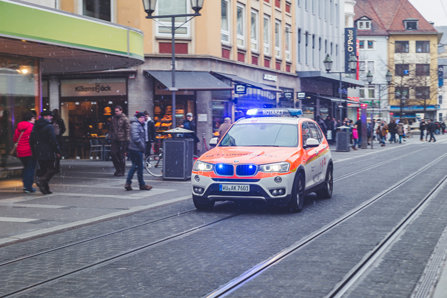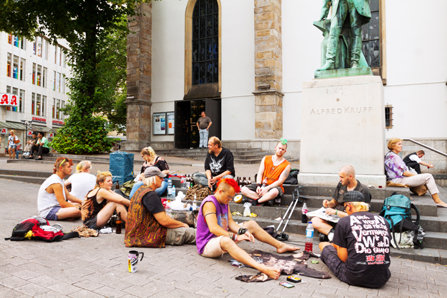Addiction Treatment Still Badly Needed in Germany

A casual observer may read news headlines and assume that Germany is alone among European countries to have avoided the worldwide opioid epidemic. But a closer look reveals that Germany has merely covered up its problem with harm reduction programs rather than addressing the addiction crisis at its root through addiction treatment.
Not only does this story act as a reminder of just how important addiction treatment is, but it shows Germans who are struggling with addiction that residential treatment is the key approach to helping them break free from drug abuse.
The Media Says Germany Escaped the Opioid Addiction Epidemic; Is That True?
Germany is sometimes compared to the United States in regards to opioid addiction, with statistics thrown around like ten times as many Americans dying from opioid overdoses than Germans, or three times as many Americans experiencing opioid addiction as Germans. These comparisons seem to reflect success on Germany’s part, but coverage is lacking in some key areas.
Germany’s public health response has indeed proven somewhat effective at avoiding the brunt of opioid-related deaths that have swept through much of the developed world. But that is likely more attributable to temporary alleviation and harm reduction directed at the country’s addicted population than any real efforts to solve the addiction crisis within Germany. In short, Germany is helping those who are addicted stay alive, but it’s not actually helping them get better.
Raw Numbers on Addiction in Germany

According to figures published by the European Monitoring Centre for Drugs and Drug Addiction:
- Germany has about 160,322 opioid addicts living in the country.
- Germany records approximately 292,227 drug-related crimes each year.
- Between 1,000 and 1,400 Germans die from opioid overdoses every year.
According to a body of research published in the National Library of Medicine, while Germany has typically kept its opioid prescribing rates low, new findings show that Germany’s prescribing rate is increasing. As prescribing rates increase, it’s almost certain that more people in Germany will become addicted to opioids.
Harm Reduction; Covering Up a Problem Without Fully Addressing It
According to Germany’s own public health data, harm reduction techniques are a big part of that nation’s focus on addressing addiction. When examining the German health department’s opioid crisis policies, public health efforts in the following areas take top positioning:
- Safe Injection Sites: Safe injection sites are legal in Germany, and in fact they are even implemented through a government program. Safe injection sites are intended to give struggling addicts a “safe” place to inject drugs with clean needles, aiming to prevent transmissible diseases like HIV/AIDS. Safe injection sites also provide a monitored setting, allowing health officials to test an addict’s drug supply and to observe addicts and provide emergency medical care should an overdose occur. The problem is, safe injection sites allow for the continuation of addiction, not its treatment.

- Needle Exchange Programs: Similar to safe injection sites, the German government created needle exchange programs that give addicts access to clean needles. These are supposed to help prevent the spread of diseases, but they simply enable addiction to continue.
- Medication-Assisted Treatment (MAT): According to the same EMCDDA report cited earlier, about 77,200 German opioid addicts are currently receiving opioid substitution medications, i.e., legal opioid medications that help ameliorate the symptoms of opioid addiction (without solving the problem of addiction itself).
These all fall under the category of harm reduction, which, as the name implies, are public health strategies that aim to reduce the harm caused by something without actually directly addressing it.
It’s worth mentioning that Germany is also deeply focused on prevention techniques, which are helpful. Some of the areas addressed include:
- Educating patients and families on drug addiction and stigma reduction.
- Surveilling physician prescribing and patient follow-up.
- Regulating opioid marketing and advertising.
- Preventing drug makers from forming financial relationships with doctors.
- Apprehending drug traffickers at country borders.
- Cracking down on internet/darknet opioid trafficking.
- Supporting law enforcement interventions in drug crime.
One of the public health responses to addiction that is sorely needed that only receives slight coverage in Germany’s public health program is that of residential addiction treatment.
Germany’s Approach to Addiction Needs Residential Treatment

When it comes to tackling the nation’s drug problem, Germany is doing some things right. From the International Society of Substance Use Professionals analysis of Germany:
1). Germany does offer a variety of treatment modalities, ranging from outpatient counseling to residential treatment.
2). Family doctors play a special role in addressing addiction, often acting as the first point of contact for drug users and at-risk individuals.
3). Germany pays particular attention to aftercare, e.g., ensuring recovering addicts have access to employment, housing, and reintegration into society.
4). Germany has created a multi-faceted prevention campaign to target the entire population with drug education and anti-drug abuse messaging, focusing particularly on at-risk groups.
The main problem in Germany is not that the country does not offer any services for drug addicts. It is that the country does not offer nearly enough residential addiction treatment to effectively treat those who are addicted to drugs. Again according to the International Society of Substance Use Professionals, the vast majority of addiction treatment in Germany is delivered in outpatient settings. By and large, outpatient services are nowhere near sufficient in helping someone get off of drugs. Instead of offering substantial residential treatment options, Germany has focused primarily on harm reduction programs and outpatient treatment.
Though Germany has kept opioid overdose fatalities relatively low despite comparatively high opioid prescribing rates, this is more the result of harm reduction techniques than actual treatment. Simply stated, Germany is covering up its problem with a bandaid rather than treating the wound directly.
To effectively combat addiction in Germany and to help German addicts get off drugs, Germany must invest in residential drug treatment programs, programs that will help addicts break free from addiction for life. And perhaps even more importantly, German families who have someone within their family who is addicted to drugs or alcohol must ensure their loved one receives treatment at a qualified rehab center, not through insufficient outpatient care or ineffective harm reduction.
Addiction treatment at residential treatment centers offers a unique, effective, comprehensive, and safe approach to helping people overcome not just their physical dependence on drugs and alcohol but the underlying issues, struggles, and hardship that led them to use drugs in the first place. Residential rehab programs get to the bottom of addiction and help people overcome the many facets and aspects of a drug problem. Such an approach is effective because it is thorough. If you know someone who is addicted to drugs in Germany and who is not being helped by the approaches available to them, please assist them in getting into a drug and alcohol rehab center as soon as possible.
Sources:
- https://www.nbcnews.com/health/health-news/how-germany-averted-opioid-crisis-n1068286
- http://www.antoniocasella.eu/archila/Germany_drug_2017.pdf
- https://pubmed.ncbi.nlm.nih.gov/31461466/
- https://www.oecd-ilibrary.org/sites/a18286f0-en/1/2/4/index.html
- https://www.issup.net/knowledge-share/country-profiles/germany


